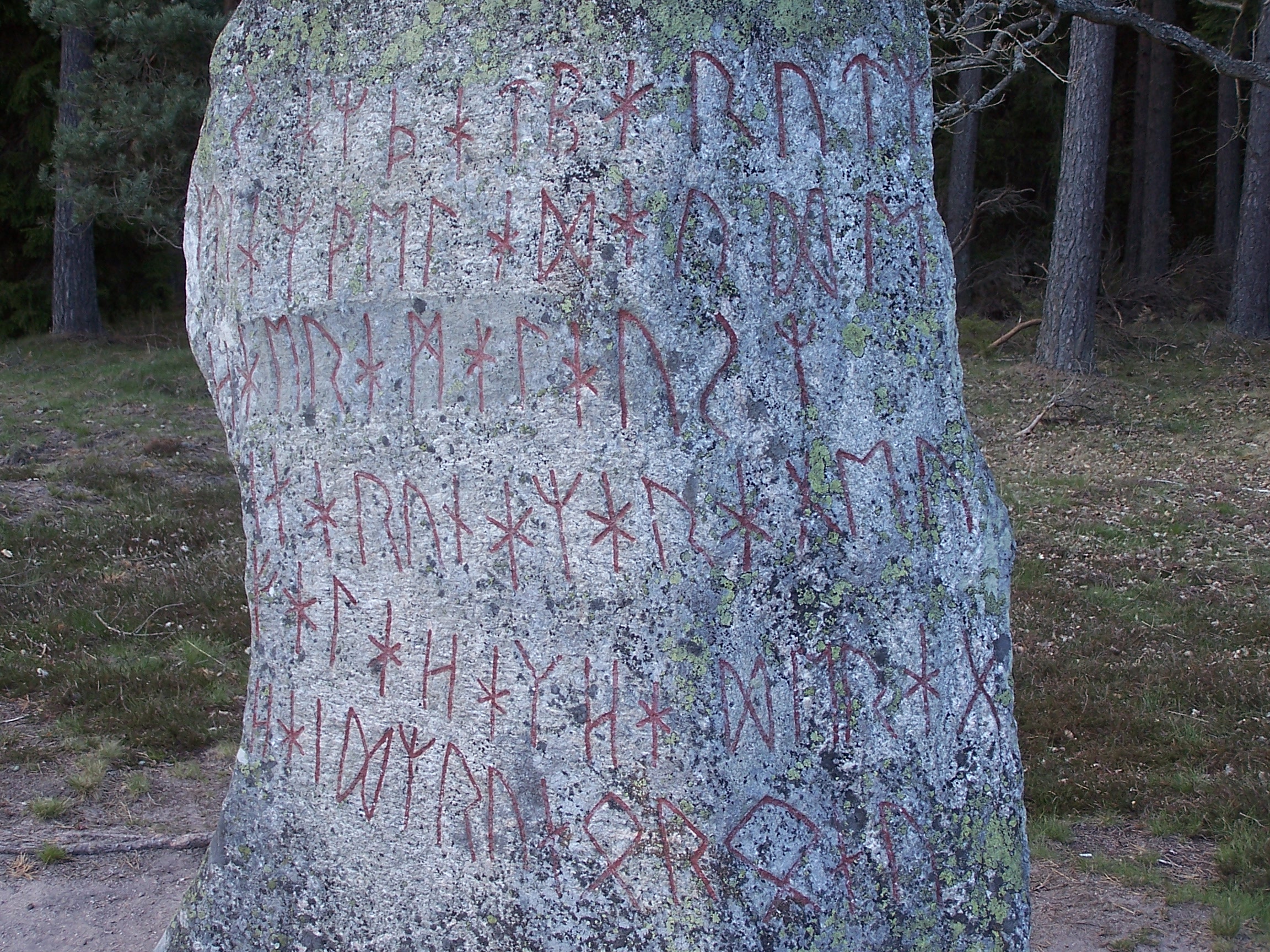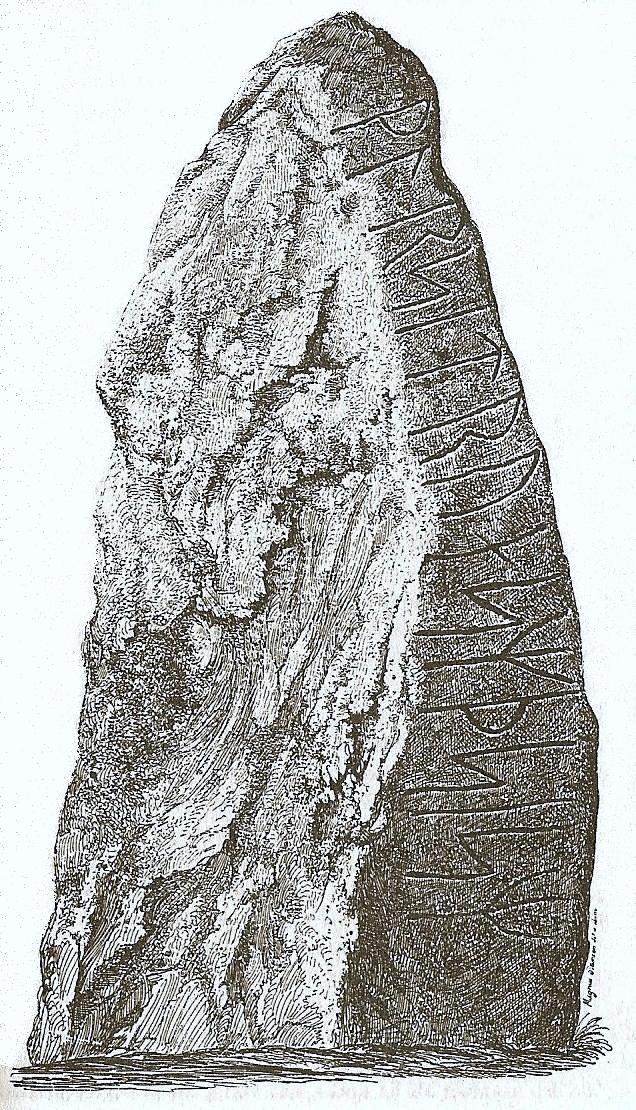|
Björketorp Runestone
The Björketorp Runestone ( DR 360 U) in Blekinge, Sweden, is part of a grave field which includes menhirs, both solitary and forming stone circles. It is one of the world's tallest runestones measuring 4.2 metres in height, and it forms an imposing sight together with two high uninscribed menhirs. Inscription The runes were made in the 6th or the 7th century and in Proto-Norse (a similar message is given on the Stentoften Runestone). It is found on two sides. The shorter message appears to say "I foresee perdition" or "prediction of perdition". The message of the other side is also debated. *A: hAidz runo ronu fAlAhAk hAiderA ginArunAz ArAgeu hAerAmAlAusz utiAz welAdAude sAz þAt bArutz *B: uþArAbA sbA Transcription: *A Haidz runo runu, falh'k hedra ginnarunaz. Argiu hermalausz, ... weladauþe, saz þat brytz. *B Uþarba spa. Translation: *A I, master of the runes(?) conceal here runes of power. Incessantly (plagued by) maleficence, (doomed to) insidious death (is) he who br ... [...More Info...] [...Related Items...] OR: [Wikipedia] [Google] [Baidu] |
Istaby Runestone
The Istaby Runestone, listed in the Rundata catalog as DR 359, is a runestone with an inscription in Proto-Norse which was raised in Istaby, Blekinge, Sweden, during the Vendel era (c. 550-790). Inscription Transliteration into Latin characters :AP :AQ :B Projektet Samnordisk runtextdatabas - entry for DR 359. Transcription into Proto-Norse :AP :AQ :BEnglish translation :AP In memory of Hariwulfar. Haþuwulfar, Heruwulfar's son, :AQ Haþuwulf(a)r, Heruwulfar's son, in memory of Hariwulfar :B wrote these runes.Interpretation The Istaby, |
Runestones With Curses
A runestone is typically a raised stone with a runic inscription, but the term can also be applied to inscriptions on boulders and on bedrock. The tradition began in the 4th century and lasted into the 12th century, but most of the runestones date from the late Viking Age. Most runestones are located in Scandinavia, but there are also scattered runestones in locations that were visited by Norsemen during the Viking Age. Runestones are often memorials to dead men. Runestones were usually brightly coloured when erected, though this is no longer evident as the colour has worn off. The vast majority of runestones are found in Sweden. History The tradition of raising stones that had runic inscriptions first appeared in the 4th and 5th century, in Norway and Sweden, and these early runestones were usually placed next to graves. The earliest Danish runestones appeared in the 8th and 9th centuries, and there are about 50 runestones from the Migration Period in Scandinavia. Most rune ... [...More Info...] [...Related Items...] OR: [Wikipedia] [Google] [Baidu] |
7th-century Inscriptions
The 7th century is the period from 601 ( DCI) through 700 ( DCC) in accordance with the Julian calendar in the Common Era. The spread of Islam and the Muslim conquests began with the unification of Arabia by Muhammad starting in 622. After Muhammad's death in 632, Islam expanded beyond the Arabian Peninsula under the Rashidun Caliphate (632–661) and the Umayyad Caliphate (661–750). The Muslim conquest of Persia in the 7th century led to the downfall of the Sasanian Empire. Also conquered during the 7th century were Syria, Palestine, Armenia, Egypt, and North Africa. The Byzantine Empire suffered setbacks during the rapid expansion of the Caliphate, a mass incursion of Slavs in the Balkans which reduced its territorial limits. The decisive victory at the Siege of Constantinople in the 670s led the empire to retain Asia Minor which assured the existence of the empire. In the Iberian Peninsula, the 7th century was known as the ''Siglo de Concilios'' (century of councils) refe ... [...More Info...] [...Related Items...] OR: [Wikipedia] [Google] [Baidu] |
6th-century Inscriptions
The 6th century is the period from 501 through 600 in line with the Julian calendar. In the West, the century marks the end of Classical Antiquity and the beginning of the Middle Ages. The collapse of the Western Roman Empire late in the previous century left Europe fractured into many small Germanic kingdoms competing fiercely for land and wealth. From the upheaval the Franks rose to prominence and carved out a sizeable domain covering much of modern France and Germany. Meanwhile, the surviving Eastern Roman Empire began to expand under Emperor Justinian, who recaptured North Africa from the Vandals and attempted fully to recover Italy as well, in the hope of reinstating Roman control over the lands once ruled by the Western Roman Empire. In its second Golden Age, the Sassanid Empire reached the peak of its power under Khosrau I in the 6th century.Roberts, J: "History of the World.". Penguin, 1994. The classical Gupta Empire of Northern India, largely overrun by the Huna, ended in ... [...More Info...] [...Related Items...] OR: [Wikipedia] [Google] [Baidu] |
Erik Moltke
Erik Moltke (4 April 1901 – 19 October 1984) was a Danish runologist, writer, and editor. Through his leadership, the Runologist Section of the National Museum of Denmark became a world centre for the scientific study of runology.Moltke, Erik (1985). ''Runes and Their Origin: Denmark and Elsewhere'', rear cover page. Copenhagen: Nationalmuseets Forlag. In 1942, Moltke and Lis Jacobsen Elisabeth (Lis) Jacobsen, née Rubin, (29 January 1882 - 18 June 1961) was a Danish philologist, archaeologist and writer. She is remembered first and foremost for her research and publications on the history of the Danish language but she was al ... published the standard edition of Danish inscriptions. Moltke also held the position of Chief Editor of the National Museum of Denmark's series of volumes on Denmark's churches until his wife Elna Møller assumed the position in 1970. Publications ''Note: This section may be incomplete.'' *Moltke, Erik (1985). ''Runes and Their Origin: Denmark an ... [...More Info...] [...Related Items...] OR: [Wikipedia] [Google] [Baidu] |
List Of Runestones
There are about 3,000 runestones in Scandinavia (out of a total of about 6,000 runic inscriptions). p. 38. The runestones are unevenly distributed in Scandinavia: The majority is found in Sweden, estimated at between 1,700 and 2,500 (depending on definition). Denmark has 250 runestones, and Norway has 50. There are also runestones in other areas reached by the Viking expansion, especially in the British Isles ( Manx runestones, Page, Raymond I. (1995). Runes and Runic Inscriptions: Collected Essays on Anglo-Saxon and Viking Runes'. Parsons, D. (ed.) Woodbridge: Boydell Press, 207–244 England runestones, Scotland and Ireland) and other islands of the North Atlantic (Faroes, Greenland, but not in Iceland), and scattered examples elsewhere (the Berezan' Runestone in Eastern Europe, Pritsak, O. (1987). ''The Origin of Rus'.'' Cambridge, Mass.: Distributed by Harvard University Press for the Harvard Ukrainian Research Institute. Sawyer, Birgit. (2000). The Viking-Age Rune-Stones: ... [...More Info...] [...Related Items...] OR: [Wikipedia] [Google] [Baidu] |
Daner
The Danes were a North Germanic tribe inhabiting southern Scandinavia, including the area now comprising Denmark proper, and the Scanian provinces of modern-day southern Sweden, during the Nordic Iron Age and the Viking Age. They founded what became the Kingdom of Denmark. The name of their realm is believed to mean " Danish March", viz. "the march of the Danes", in Old Norse, referring to their southern border zone between the Eider and Schlei rivers, known as the Danevirke. Origins The origin of the Danes remains undetermined, but several ancient historical documents and texts refer to them and archaeology has revealed and continues to reveal insights into their culture, beliefs, organization and way of life. The Danes first appear in written history in the 6th century with references in Jordanes' ''Getica'' (551 AD), by Procopius, and by Gregory of Tours. They spoke Old Norse (''dǫnsk tunga''), which the Danes shared with the people in Norway and Sweden and later in Iceland ... [...More Info...] [...Related Items...] OR: [Wikipedia] [Google] [Baidu] |
Odin
Odin (; from non, Óðinn, ) is a widely revered Æsir, god in Germanic paganism. Norse mythology, the source of most surviving information about him, associates him with wisdom, healing, death, royalty, the gallows, knowledge, war, battle, victory, sorcery, poetry, frenzy, and the Runes, runic alphabet, and depicts him as the husband of the goddess Frigg. In wider Germanic mythology and paganism, the god was also known in Old English as ', in Old Saxon as , in Old Dutch as ''Wuodan'', in Old Frisian as ''Wêda'', and in Old High German as , all ultimately stemming from the Proto-Germanic language, Proto-Germanic theonym *''Wōðanaz'', meaning 'lord of frenzy', or 'leader of the possessed'. Odin appears as a prominent god throughout the recorded history of Northern Europe, from the Roman occupation of regions of Germania (from BCE) through movement of peoples during the Migration Period (4th to 6th centuries CE) and the Viking Age (8th to 11th centuries CE). In the modern pe ... [...More Info...] [...Related Items...] OR: [Wikipedia] [Google] [Baidu] |
Cenotaph
A cenotaph is an empty tomb or a monument erected in honour of a person or group of people whose remains are elsewhere. It can also be the initial tomb for a person who has since been reinterred elsewhere. Although the vast majority of cenotaphs honour individuals, many noted cenotaphs are instead dedicated to the memories of groups of individuals, such as the lost soldiers of a country or of an empire. Etymology The word "cenotaph" in the English Language is derived from the Greek el, κενοτάφιον, kenotaphion, label=none. It is a compound word that is created from the morphological combination of two root words: # el, κενός, kenos, label=none meaning "empty" # el, τάφος, taphos, label=none meaning "tomb", from el, θαπτω, thapto, I bury, label=none History Cenotaphs were common in the ancient world. Many were built in Ancient Egypt, Ancient Greece and across Northern Europe (in the shape of Neolithic barrows). The cenotaph in Whitehall, Lon ... [...More Info...] [...Related Items...] OR: [Wikipedia] [Google] [Baidu] |
Copenhagen Fire Of 1728
The Copenhagen Fire of 1728 was the largest fire in the history of Copenhagen, Denmark. It began on the evening of 20 October 1728 and continued to burn until the morning of 23 October. It destroyed approximately 28% of the city (measured by counting the number of destroyed lots from the cadastre) and left 20% of the population homeless. The reconstruction lasted until 1737. No less than 47% of the section of the city, which dates back to the Middle Ages, was completely lost, and along with the Copenhagen Fire of 1795, it is the main reason that few traces of medieval Copenhagen can be found in the modern city. Although the number of dead and wounded was relatively low compared to the extent of the fire, the cultural losses were huge. In addition to several private book collections, 35,000 texts including a large number of unique works were lost with the University of Copenhagen library, and at the observatory on top of Rundetårn, instruments and records made by Tycho Brahe and ... [...More Info...] [...Related Items...] OR: [Wikipedia] [Google] [Baidu] |







